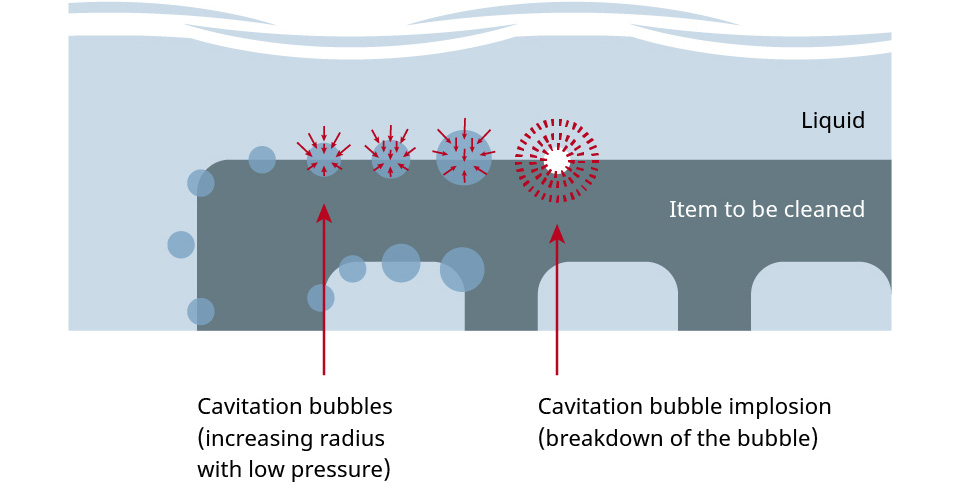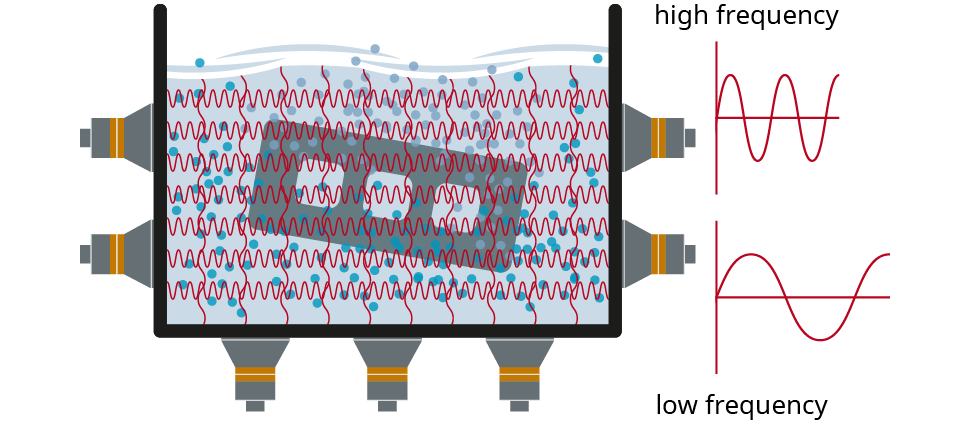Ultrasonic cleaning for the medical technology sector – A KKS core competence
Every surface treatment process requires a preliminary and a final cleaning stage. Over the years, ultrasonic cleaning has become an established and proven cleaning process in many demanding industries, including the medical technology sector. Using ultrasonic technology in combination with aqueous media achieves the highest degree of cleanliness with relatively short cleaning cycles. Even complex, delicate parts with structured, porous surfaces and the tiniest grooves and holes can be cleaned with highest purity. Ultrasonic cleaning is both an extremely thorough and – assuming the appropriate parameters are chosen – gentle process for the cleaning of delicate surfaces, making it an indispensable technology for cleaning products with the highly stringent purity requirements.
Ultrasonic cleaning – A KKS core competence: Your advantages
Ultrasonic cleaning – How it works:
The electrical alternating field energy produced by an ultrasonic generator is converted into mechanical energy by piezoelectric transducer systems and transmitted into the bath liquid, causing pressure changes within the liquid. The resulting cavitation determines the cleaning effect of ultrasonic-assisted cleaning, making it easy to clean even the smallest, hard-to-reach problem areas with maximum efficiency during ultrasonic cleaning.
The pressure fluctuations (expansion and compression) induced by ultrasound destroy the liquid binding, resulting in the creation of transient and bubble-like gas pockets. The vapor condenses out again in the “compression phase”.
Millions of microscopically small cavities with fluctuating size are created. If a sufficiently high level of ultrasonic energy is introduced, the size of the cavitation bubble can no longer oscillate in a stable manner and implodes during the next compression phase (“transient cavitation”). This produces high levels of local pressure (shock waves) and a strong liquid flow (“microjet”) that collides with the surface of the part to be cleaned at a speed of up to 400km/h. It is this liquid flow that is in fact responsible for removing particles of dirt from the surface of a part. Cavitation bubbles usually collapse at the boundary layers between the liquid and the item being cleaned. The resulting inflow of liquid (“microjet”) is directed towards the cleaning media, right where it is needed for cleaning.
Cleaning factors during cleaning with ultrasonic technology
A range of parameters need to be taken into account for effective ultrasonic cleaning for medical technology sector.
- The material of the parts and the nature of the contamination determine which type of cleaning media is to be used.
- The extent of the contamination and the cleaning agent dictate the temperature that is set and the duration of the cleaning process.
- The level of the contamination and the sensitivity of the material of the parts define the ultrasonic parameters to be applied.
Ultrasonic-assisted rinsing of the parts with water of varying quality is also extremely important to ensure that the cleaning agents and all the contaminants they have picked up are completely removed from the surface of the parts. A combination of osmosis water and demineralized water after cleaning guarantees a spotless finish after drying.
KKS DUAL and MIX ultrasonic cleaning for increased efficiency
The DUAL and MIX ultrasonic cleaning technology used by KKS is among the most efficient and effective ultrasonic cleaning methods. The combination of coarse and fine cleaning in a single process achieves greater flexibility and unprecedented cleaning results. As such, parts made from different materials and that exhibit different degrees of soiling are cleaned efficiently, gently and with maximum precision.
The combination of low and high ultrasonic frequencies makes cleaning more intense. The ultrasonic technology developed by KKS can generate harmonized frequency pairings for ultrasonic cleaning, either sequentially (DUAL) or simultaneously (MIX).
At low frequencies, the DUAL or MIX frequency technology produces fewer, larger cavitation bubbles with high implosion forces. The complex layers of dirt are blown off and the surface structure is enhanced.
At high frequencies, more – albeit smaller – cavitation bubbles form with lower implosion forces. These smaller cavitation bubbles ensure that impurities are also removed from porous surfaces, open-pored structures, as well as the tiniest holes and delicate structures.
The KKS MIX ultrasonic cleaning technology generates two different frequencies in the bath at the same time, achieving the respective effects of low and high frequencies all at once! Simultaneous treatment with two harmonic frequencies such as 27/80 kHz, 30/60 kHz or 40/100 kHz therefore provides excellent cleaning results.
Ultrasonic cleaning for your medical products
We offer you safe and clean implants and medical instruments. Our services reach from the optimization or development of your individual surface process, the very surface treatment and ultrasonic cleaning to the final cleaning and packaging in a clean room of clean room class ISO 8. On request, we also carry out the process validation for your products. Find out more on our website or discuss your individual requirements with our surface specialists. We are looking forward to your contact.





